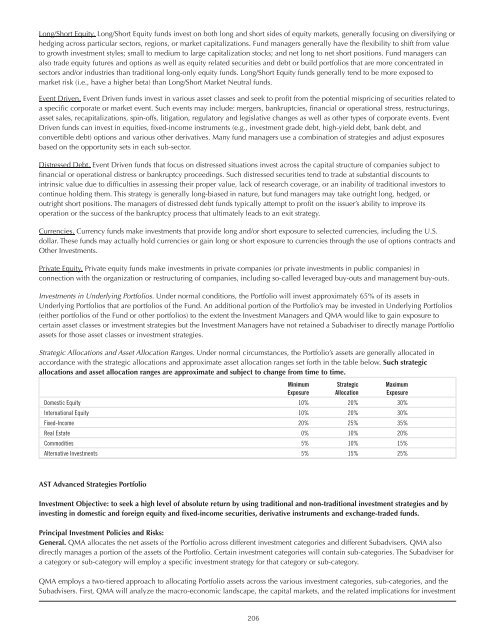Advanced Series Trust AST Academic Strategies Asset ... - Prudential
Advanced Series Trust AST Academic Strategies Asset ... - Prudential
Advanced Series Trust AST Academic Strategies Asset ... - Prudential
You also want an ePaper? Increase the reach of your titles
YUMPU automatically turns print PDFs into web optimized ePapers that Google loves.
Long/Short Equity. Long/Short Equity funds invest on both long and short sides of equity markets, generally focusing on diversifying or<br />
hedging across particular sectors, regions, or market capitalizations. Fund managers generally have the flexibility to shift from value<br />
to growth investment styles; small to medium to large capitalization stocks; and net long to net short positions. Fund managers can<br />
also trade equity futures and options as well as equity related securities and debt or build portfolios that are more concentrated in<br />
sectors and/or industries than traditional long-only equity funds. Long/Short Equity funds generally tend to be more exposed to<br />
market risk (i.e., have a higher beta) than Long/Short Market Neutral funds.<br />
Event Driven. Event Driven funds invest in various asset classes and seek to profit from the potential mispricing of securities related to<br />
a specific corporate or market event. Such events may include: mergers, bankruptcies, financial or operational stress, restructurings,<br />
asset sales, recapitalizations, spin-offs, litigation, regulatory and legislative changes as well as other types of corporate events. Event<br />
Driven funds can invest in equities, fixed-income instruments (e.g., investment grade debt, high-yield debt, bank debt, and<br />
convertible debt) options and various other derivatives. Many fund managers use a combination of strategies and adjust exposures<br />
based on the opportunity sets in each sub-sector.<br />
Distressed Debt. Event Driven funds that focus on distressed situations invest across the capital structure of companies subject to<br />
financial or operational distress or bankruptcy proceedings. Such distressed securities tend to trade at substantial discounts to<br />
intrinsic value due to difficulties in assessing their proper value, lack of research coverage, or an inability of traditional investors to<br />
continue holding them. This strategy is generally long-biased in nature, but fund managers may take outright long, hedged, or<br />
outright short positions. The managers of distressed debt funds typically attempt to profit on the issuer’s ability to improve its<br />
operation or the success of the bankruptcy process that ultimately leads to an exit strategy.<br />
Currencies. Currency funds make investments that provide long and/or short exposure to selected currencies, including the U.S.<br />
dollar. These funds may actually hold currencies or gain long or short exposure to currencies through the use of options contracts and<br />
Other Investments.<br />
Private Equity. Private equity funds make investments in private companies (or private investments in public companies) in<br />
connection with the organization or restructuring of companies, including so-called leveraged buy-outs and management buy-outs.<br />
Investments in Underlying Portfolios. Under normal conditions, the Portfolio will invest approximately 65% of its assets in<br />
Underlying Portfolios that are portfolios of the Fund. An additional portion of the Portfolio’s may be invested in Underlying Portfolios<br />
(either portfolios of the Fund or other portfolios) to the extent the Investment Managers and QMA would like to gain exposure to<br />
certain asset classes or investment strategies but the Investment Managers have not retained a Subadviser to directly manage Portfolio<br />
assets for those asset classes or investment strategies.<br />
Strategic Allocations and <strong>Asset</strong> Allocation Ranges. Under normal circumstances, the Portfolio’s assets are generally allocated in<br />
accordance with the strategic allocations and approximate asset allocation ranges set forth in the table below. Such strategic<br />
allocations and asset allocation ranges are approximate and subject to change from time to time.<br />
Minimum<br />
Exposure<br />
Strategic<br />
Allocation<br />
Maximum<br />
Exposure<br />
Domestic Equity 10% 20% 30%<br />
International Equity 10% 20% 30%<br />
Fixed-Income 20% 25% 35%<br />
Real Estate 0% 10% 20%<br />
Commodities 5% 10% 15%<br />
Alternative Investments 5% 15% 25%<br />
<strong>AST</strong> <strong>Advanced</strong> <strong>Strategies</strong> Portfolio<br />
Investment Objective: to seek a high level of absolute return by using traditional and non-traditional investment strategies and by<br />
investing in domestic and foreign equity and fixed-income securities, derivative instruments and exchange-traded funds.<br />
Principal Investment Policies and Risks:<br />
General. QMA allocates the net assets of the Portfolio across different investment categories and different Subadvisers. QMA also<br />
directly manages a portion of the assets of the Portfolio. Certain investment categories will contain sub-categories. The Subadviser for<br />
a category or sub-category will employ a specific investment strategy for that category or sub-category.<br />
QMA employs a two-tiered approach to allocating Portfolio assets across the various investment categories, sub-categories, and the<br />
Subadvisers. First, QMA will analyze the macro-economic landscape, the capital markets, and the related implications for investment<br />
206

















